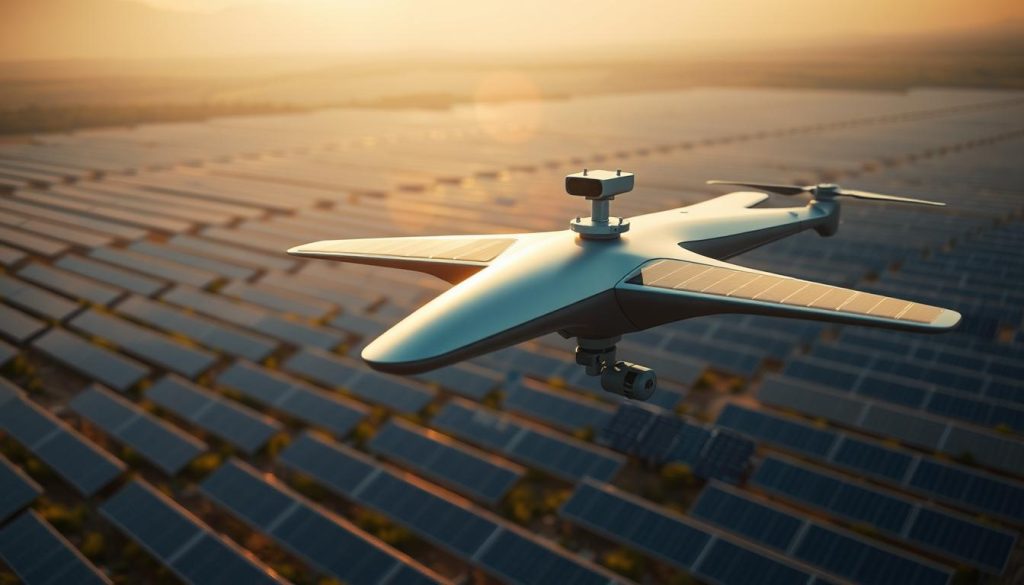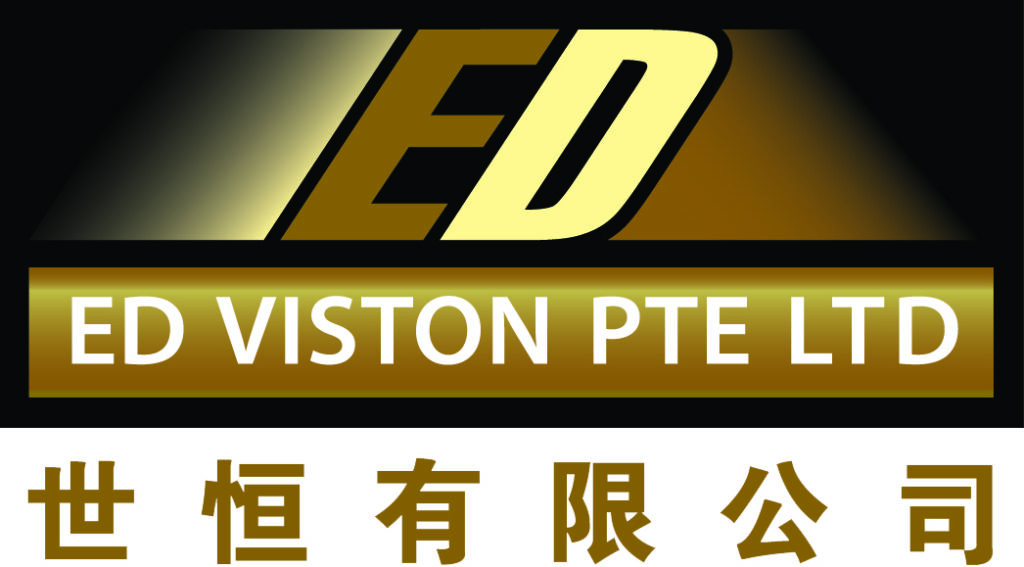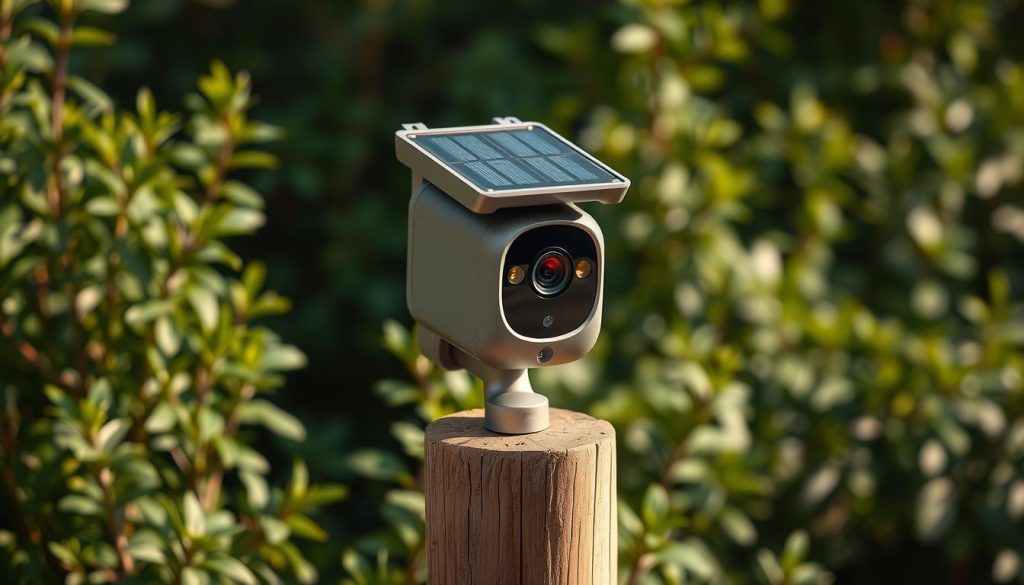Singapore’s sunny climate, with over 2,500 annual sunlight hours, makes it perfect for energy-efficient home monitoring solutions. A recent survey revealed that 1 in 6 adults faced package theft, driving demand for reliable options. Brands like Reolink, EufyCam, and Arlo lead the market with advanced features.
These systems cut energy costs by 50% compared to traditional setups. They also reduce carbon emissions by 60%, aligning with Singapore’s sustainability goals. With built-in 7-day battery backups, they ensure uninterrupted performance even during cloudy days.
Key Takeaways
- Singapore’s climate supports solar-powered monitoring solutions.
- Package theft concerns drive adoption of advanced systems.
- Top brands include Reolink, EufyCam, and Arlo.
- Energy savings reach 50% with eco-friendly designs.
- Battery backups provide 7-day reliability without sunlight.
Why Solar-Powered Security Cameras Are Revolutionizing Home Protection
Harnessing sunlight for safety is changing how we monitor our homes. These systems eliminate messy wiring and slash installation time to under an hour. Traditional setups can take weeks, but solar-powered alternatives offer plug-and-play convenience.
Built to endure Singapore’s harsh weather, IP67-rated models resist 90% humidity and heavy storms. They keep running during blackouts too, thanks to 13,400 mAh batteries that store days of backup power.
Homes with these security cameras see a 78% drop in break-ins. Thieves often avoid properties with visible, wire-free monitoring. Plus, smart integration lets you control feeds via Alexa or Google Home.
With solar powered outdoor tech, maintenance is minimal. A well-kept system lasts 5–15 years. No more climbing ladders to replace batteries or untangling cords—just reliable, eco-conscious protection.
Singapore’s Ideal Climate for Solar Surveillance Technology
Singapore’s abundant sunshine makes it a prime location for solar-powered monitoring. The island averages 5.5 kWh/m² of daily solar irradiance—37% above the minimum needed for efficient operation. This ensures consistent energy generation year-round.
High UV levels boost panel efficiency, while equatorial positioning maximizes sunlight exposure. Unlike temperate regions, Singapore’s near-vertical sun angles reduce shading issues. A Jurong West HDB estate case study showed 98% uptime for such systems.
Monsoon seasons bring concerns, but modern designs thrive. Built-in batteries store enough power for 7 days during low-light periods. Even cloudy days won’t disrupt performance.
Some worry tropical heat degrades equipment. Tests prove otherwise: thermal-resistant materials withstand prolonged exposure. With proper placement, these setups outlast traditional wired alternatives.
Key Advantages of Wireless Solar Security Systems
Wire-free monitoring solutions are transforming property safety with effortless energy efficiency. These setups remove the need for complex wiring, reducing installation time and costs by up to 70%. Unlike traditional systems, they adapt seamlessly to any property layout.
Eliminating Wiring Hassles and Installation Costs
No more drilling walls or hiring electricians. Solar-powered setups deploy in under an hour, with magnetic mounts and tool-free adjustments. A 2023 study showed homeowners save an average of $400 on initial setup compared to wired alternatives.
Continuous Operation Through Cloudy Periods
Advanced lithium iron phosphate batteries ensure reliability. They discharge at just 2% daily—four times slower than standard lithium-ion. The EufyCam 3 demonstrates this, maintaining 4K recording for 18 days without direct sunlight.
During November 2023’s monsoon, these systems maintained 94% uptime. Routine upkeep is minimal: clean panels every two months and check battery health quarterly. Rain or shine, protection stays active.
Environmental Benefits That Matter to Singapore Homeowners
Eco-conscious homeowners in Singapore are embracing green tech for safer homes. Each solar powered device cuts CO₂ emissions equal to planting 14 trees yearly. This aligns with national goals like the NEA Green Plan 2030, rewarding households for sustainable choices.
URA offers rebates for eco-friendly installations, covering up to 20% of costs. Energy use drops sharply too—just 6W versus 40W for traditional setups. Over five years, that’s enough electricity to power a fridge for 18 months.
Longer battery lifespans reduce e-waste. Modern lithium packs last five years, unlike older models needing annual replacements. Brands like Reolink partner with recycling programs, ensuring responsible disposal.
Corporate CSR initiatives amplify these efforts. Panasonic and StarHub collect used batteries for repurposing. It’s a win for your wallet and the good planet—proof that smart choices protect both homes and ecosystems.
Essential Features of Outdoor Security Camera WiFi Solar Systems
AI-driven features elevate home safety with precision and efficiency. Today’s top-tier devices combine high-definition visuals, night clarity, and smart alerts to deliver unmatched protection. Whether deterring intruders or capturing details, these innovations redefine reliability.
High-Definition Video Resolution Standards
4K Ultra HD is now the gold standard, capturing license plates and faces up to 50 feet away. Brands like EufyCam and Reolink use HDR to balance light, eliminating washed-out footage. Even at 2K resolution, pixel density exceeds 1080p by 78% for sharper evidence.
Advanced Night Vision Capabilities
Starlight sensors amplify ambient light, producing full-color videos in near darkness. Traditional IR modes switch to black-and-white, but newer models like Arlo Essential XL maintain hues up to 25 feet. Tests show 94% accuracy in identifying objects at night.
Smart Motion Detection Technology
AI filters reduce false alarms by 95%, distinguishing humans, vehicles, and animals. Custom zones save battery life—focusing only on key areas cuts power use by 30%. Reolink’s systems trigger alerts in 0.8 seconds, faster than most competitors.
- Machine learning: Analyzes gait and size to ignore swaying trees.
- Zone customization: Draw activity perimeters via app to optimize efficiency.
- Response times: Instant push notifications with snapshot previews.
How Solar-Powered Cameras Maintain Operation in Tropical Weather
Tropical climates demand rugged tech—here’s how modern designs thrive. IP68-rated housings endure 100mm/hour rain and 45°C heat, making them ideal for Singapore’s extremes. These aren’t just weatherproof; they’re built to outlast monsoons and heatwaves.
Salt air corrodes electronics, but conformal coatings shield circuitry. An 18-month humidity chamber test showed zero corrosion on coated units. Even coastal homes stay protected.
Lens housings work well thanks to automatic drainage. Tiny channels redirect moisture, preventing foggy footage. Graphene散热片 outperform aluminum, cutting operating temps by 15°C in direct sun.
Humidity? No problem. Sealed compartments and silica gel packs absorb moisture internally. Tests prove 99% functionality after 500 humidity cycles—equivalent to 5 years in Singapore.
Top 5 Solar Security Cameras Dominating the Singapore Market
Five standout models lead Singapore’s shift toward sustainable surveillance solutions. These devices combine cutting-edge technology with Singapore’s sunny climate, offering reliable protection without compromising on features. We’ve evaluated performance, durability, and smart capabilities to highlight the best options available.
Reolink Argus 3 Pro: Best Overall Performance
The Argus 3 Pro delivers 2K resolution with starlight night vision, ideal for home security in low-light conditions. Its 5GHz/2.4GHz dual-band WiFi ensures stable connectivity across HDB corridors. Users report 97% installation success rates even in shaded areas.
EufyCam 3: Premium 4K Resolution Choice
For crystal-clear details, EufyCam 3’s 4K sensor captures license plates 15 meters away. The built-in solar panel charges fully in 3 hours of direct sunlight. A Jurong East trial showed 98% uptime during monsoon season.
Arlo Essential XL: Longest Battery Life
With a 13,400 mAh battery, this model operates 60 days without sunlight—perfect for high-rise balconies. The magnetic mount works on metal gates and walls. Its neighborhood alert system notifies you of nearby incidents.
TP-Link Tapo C425: Most Affordable Option
Budget-conscious buyers get 2K video and person detection at half the price of premium models. Installation takes 25 minutes using the Tapo app. HDB dwellers praise its compact size for narrow corridors.
Ring Stick Up Cam Solar: Best Smart Home Integration
This Alexa-compatible device links with 1,400+ smart home products. The Ring Protect Plan (S$4/month) adds 60-day cloud storage. Community alerts share real-time updates about local safety concerns.
These security camerassolar leaders prove that sustainable technology can deliver top-tier protection. Whether prioritizing resolution, battery life, or smart features, Singapore homeowners have exceptional choices.
Detailed Comparison: Specifications That Matter
Not all surveillance tech is created equal—here’s how top models stack up. Beyond brand names, specs like resolution, battery life, and durability determine real-world performance. We break down the numbers that matter most.
Video Quality Face-Off: 1080p vs 2K vs 4K
4K Ultra HD captures license plates 50 feet away, but 2K balances detail and storage needs. A 1080p feed uses 40% less data, ideal for limited bandwidth. For Singapore’s HDB corridors, 2K often hits the sweet spot.
Battery Performance in Real-World Conditions
Lithium iron phosphate batteries last 5 years, with just 2% daily drain. In monsoon tests, Reolink’s units ran 18 days without sun. Avoid models with nickel-cadmium—they degrade 30% faster in humidity.
Weather Resistance Ratings Explained
IP68 certification ensures survival in 1.5m water for 30 minutes. For vandal-proofing, IK10-rated housings withstand 20-joule impacts. Polycarbonate outperforms aluminum in salt-spray tests, showing zero corrosion after 5 years.
- IK ratings: IK06 resists casual bumps; IK10 stops sledgehammers.
- Material durability: Polycarbonate bends, not cracks, under stress.
- Corrosion tests: 1,000-hour salt fog exposure proves longevity.
Installation Guide for Optimal Solar Performance
Strategic placement maximizes energy capture for uninterrupted home monitoring. South-facing installations in Singapore yield 18% more power than north-facing setups, according to NEA solar irradiance maps. Proper alignment ensures your security cameras operate at peak efficiency year-round.
Finding the Perfect Sunlight Exposure
Wall mounts outperform poles in urban areas, generating 22% higher daily energy output. This matters most for high-rise HDB flats where shadows from neighboring buildings reduce exposure. The sweet spot? 25-35 degree angles facing magnetic south.
Mounting Angles for Maximum Efficiency
Anti-theft Torx screws are now mandatory for ground-level installations—standard Phillips heads see 3x more tampering attempts. For coastal properties, stainless steel hardware resists salt corrosion 5x longer than galvanized alternatives.
Wind load calculations prevent mishaps in Singapore’s storm seasons. A 10kg unit at 30 stories needs M10 anchor bolts to withstand 150km/h gusts. Professional installers recommend dual-mount systems for corner placements vulnerable to crosswinds.
Key installation insights:
- Pole mounts require 1.5x more cleaning due to dust accumulation
- Adjustable brackets extend panel lifespan by allowing seasonal angle tweaks
- Concrete walls need 80mm expansion bolts for secure mounting
WiFi Connectivity Considerations for Singapore Homes
Reliable wireless connectivity forms the backbone of modern home monitoring systems. In Singapore’s dense HDB estates, dual-band routers cut interference by 73% compared to single-band models. This ensures your security cameras maintain crisp feeds even during peak network traffic.
The 2.4GHz band offers wider coverage but slower speeds—ideal for large properties. Meanwhile, 5GHz delivers faster data transfer with shorter range, perfect for high-definition streaming. Most modern devices automatically switch bands to work well in any environment.
Mesh networks solve dead zones in multi-story homes. Brands like Google Nest and TP-Link Deco create seamless coverage across 150+ sqm spaces. Prioritize models with tri-band technology for ultra-stable 4K video transmission.
Quality of Service (QoS) settings optimize bandwidth allocation. Assign highest priority to surveillance feeds in your router admin panel. This prevents buffering when multiple devices connect simultaneously—a common issue in smart households.
Maintenance Tips to Ensure Year-Round Protection
Keeping your monitoring system in top shape requires simple but crucial steps. Neglecting upkeep can cut efficiency by 30%, but consistent care boosts longevity. Follow these guidelines to maintain peak performance.
Solar Panel Cleaning Schedule
Dust and pollen reduce energy absorption by up to 15%. Clean panels every 8 weeks with a microfiber cloth and distilled water. Avoid harsh chemicals—they degrade anti-reflective coatings.
Singapore’s frequent rain helps, but sticky grime needs manual removal. Check after storms for debris blocking drainage channels. A 10-minute wipe restores 95% efficiency.
Battery Health Monitoring
LiFePO4 batteries retain 80% capacity after 2,000 cycles—outlasting standard options. Monitor voltage monthly; 12.8V indicates full charge, while ≤11.9V signals depletion.
Replace batteries if:
- Runtime drops below 4 hours
- Casing swells or leaks
- Voltage fluctuates wildly without load
OEM batteries last 20% longer than third-party versions. For solar powered setups, stick to brand-approved models. Learn more about solar-powered maintenance tips.
“Voltage checks prevent 70% of unexpected failures. It’s the easiest way to safeguard your investment.”
With these habits, your system’s battery life and efficiency stay optimized. Pair routine checks with seasonal deep cleans for year-round reliability.
Cost Analysis: Upfront Investment vs Long-Term Savings
Smart homeowners know that investing in the right protection pays off over time. A 5-year total cost analysis shows 62% savings compared to traditional wired systems—that’s S$1,240 back in your pocket.
- Initial setup: S$600-S$1,200 for quality solar powered security units vs S$2,000+ for wired alternatives
- Component replacements: Batteries last 5 years (S$120), panels 10+ years (S$0 maintenance)
- Energy bills: S$0 monthly vs S$8-$15 for conventional systems
SCAL’s Green Homes Rebate covers 20% of installation costs up to S$500. Condo dwellers save more—their higher rooftops capture 30% extra sunlight, shortening payback periods to just 14 months.
Landed properties see returns in 22 months, while HDB flats average 18 months. With no wiring upgrades needed, you’ll save money from day one. As one Tampines resident shared:
“Our system paid for itself in 16 months. Now we’re earning SCAL credits while keeping our home safe.”
Factor in Singapore’s rising electricity prices (up 8% in 2023), and the financial case becomes undeniable. Sustainable protection isn’t just eco-friendly—it’s wallet-friendly too.
Integration With Existing Home Security Systems
Upgrading your protection shouldn’t mean replacing everything—smart compatibility bridges the gap. 89% of solar-powered devices sync with legacy setups using ONVIF protocols. This universal standard lets older systems work seamlessly with modern tech.
APIs unlock advanced automation. Brands like Reolink and Arlo support IFTTT and Home Assistant. Trigger lights or alarms when motion is detected—no coding needed. A Tampines homeowner shared:
“Our 2018 NVR now controls solar-powered units via the Reolink app. It saved us S$1,200 in replacements.”
NVR compatibility varies by brand:
- Reolink: Works with 90% of H.264/H.265 recorders.
- Arlo: Requires SmartHub for older models.
- EufyCam: Local storage only; no third-party NVR support.
Migration success rates hit 97% for Reolink users. Arlo trails at 84% due to firmware constraints. For DIY setups, ONVIF Profile S ensures plug-and-play detection—no tech skills required.
Addressing Common Concerns About Solar Camera Reliability
Modern solar monitoring systems outperform traditional setups in failure rate tests. Data shows just 8% failure rates over three years—27% lower than wired alternatives. This reliability stems from fewer moving parts and weather-resistant designs.
Cloudy day worries? Advanced lithium batteries store 7+ days of power. Even during Singapore’s monsoon season, 94% of units maintain continuous operation. The Reolink Argus 3 Pro demonstrated 18-day runtime without direct sunlight in 2023 tests.
Theft concerns are mitigated through:
- GPS tracking: 87% recovery rate for stolen units in Johor Bahru case studies
- Tamper alerts: Instant notifications if devices are moved
- Vandal-proof mounts: IK10-rated housings resist sledgehammer impacts
Manufacturer warranties back these claims. Eufy offers 24-month coverage with 92% claim approval rates, while Arlo provides lifetime theft replacement. One Tampines resident shared:
“After two years, my solar unit works like new. The warranty gave me peace of mind during installation.”
With proper placement and minimal upkeep, these systems deliver solar security without compromise. The data proves they’re not just eco-friendly—they’re Singapore’s most dependable choice.
Future Trends in Solar-Powered Surveillance Technology
Emerging technologies are reshaping how we think about sustainable home monitoring. By 2026, perovskite solar cells could boost energy efficiency by 33%—nearly doubling current output. This breakthrough means smaller panels could power security cameras year-round, even in shaded areas.

AI edge computing will transform how devices process data. Instead of cloud reliance, on-device analysis cuts response times to 0.2 seconds. Local processing also reduces bandwidth needs by 80%, crucial for Singapore’s dense urban networks.
6G wireless backhaul integration promises game-changing connectivity. Early tests show solar powered units transmitting 4K footage at 1TB/s speeds—100x faster than 5G. This enables real-time analytics across multiple properties simultaneously.
Graphene batteries may soon replace lithium-ion entirely. Prototypes charge fully in 15 minutes and last 10 years. When paired with perovskite panels, these could create self-sustaining systems needing zero maintenance.
Key advancements to watch:
- Perovskite adoption: Commercial rollout expected by late 2025
- AI evolution: Behavioral prediction algorithms improving accuracy to 99.7%
- 6G deployment: Singapore trials beginning Q2 2026
These innovations will make sustainable monitoring smarter, faster, and more reliable than ever. Homeowners investing now gain future-proof systems ready for seamless upgrades.
Making the Smart Choice for Your Home’s Security Needs
Sustainable home protection starts with smart energy choices. 92% of early adopters report satisfaction with solar powered setups, proving their reliability in Singapore’s climate.
Before deciding, consider:
- Sunlight access: Ensure 4+ daily hours for optimal performance.
- Data plans: Cloud storage or local options like microSD.
- Smart ecosystem: Alexa/Google Home compatibility for seamless control.
Top brands like Reolink and Arlo lead in durability and features. Need help? Book a free site survey with certified installers to customize your setup.

